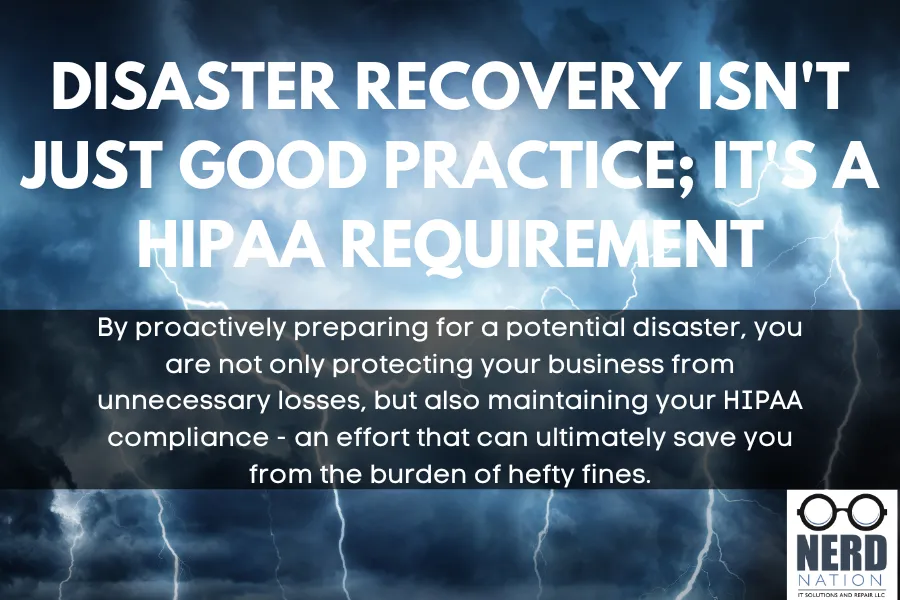Blog
Business IT articles and News

Disaster Recovery Isn't Just Good Practice; It's a HIPAA Requirement
Disaster Recovery Isn't Just Good Practice; It's a HIPAA Requirement
By proactively preparing for a potential disaster, you are not only protecting your business from unnecessary losses, but also maintaining your HIPAA compliance - an effort that can ultimately save you from the burden of hefty fines.
Introduction
Disaster recovery is an important part of any organization's strategy to protect their data and systems. It is especially critical for organizations that are subject to the requirements of the Health Insurance Portability and Accountability Act (HIPAA). Not only is disaster recovery good practice, it is also a requirement of HIPAA. In this blog post, we will explore how disaster recovery relates to HIPAA and why it is essential for organizations to understand and meet the requirements set out by HIPAA.
What is disaster recovery and why is it important in healthcare?

Disaster recovery refers to the processes and procedures an organization has in place to recover its critical systems and data after a disruptive event such as a natural disaster, cyberattack, or system failure. In healthcare, disaster recovery is particularly important because it involves the protection and recovery of sensitive patient data.
The healthcare industry relies heavily on electronic systems to store and process patient information. This includes personally identifiable information (PII), such as names, addresses, social security numbers, and medical records. Protecting this data is not only crucial for the privacy and security of patients, but it is also required by HIPAA.
In the event of a disaster, healthcare organizations must be able to quickly recover their systems and data to ensure uninterrupted patient care. This is especially critical when it comes to access to medical records and other critical information that healthcare providers need to make informed decisions about patient treatment.
Disaster recovery in healthcare involves creating backups of important data and systems, implementing redundant infrastructure to minimize downtime, and developing detailed plans and procedures for recovering from different types of disasters. These plans must be regularly tested and updated to ensure their effectiveness.
In addition to the immediate benefits of protecting patient data and maintaining continuity of care, effective disaster recovery in healthcare also helps organizations comply with HIPAA regulations. Failure to have adequate disaster recovery plans in place can result in significant fines and penalties for non-compliance.
In summary, disaster recovery is crucial in healthcare to protect sensitive patient data, ensure continuity of care, and comply with HIPAA regulations. Implementing robust disaster recovery plans and procedures is essential for the security and well-being of both healthcare organizations and the patients they serve.
Click Here to Schedule your free HIPAA Audit Today!
HIPAA requirements for disaster recovery planning
HIPAA (Health Insurance Portability and Accountability Act) has specific requirements for disaster recovery planning that healthcare organizations must adhere to in order to protect sensitive patient data and maintain continuity of care. These requirements aim to ensure that healthcare organizations are adequately prepared for potential disasters and can quickly recover their systems and data in the event of an incident.
One of the key requirements of HIPAA is the creation of a comprehensive and effective disaster recovery plan. This plan must outline the organization's strategy for protecting and recovering critical systems and data in the event of a disaster. It should address how backups of important data and systems will be created, how redundant infrastructure will be implemented to minimize downtime, and how detailed plans and procedures for recovery will be developed.
HIPAA also requires healthcare organizations to regularly test and update their disaster recovery plans to ensure their effectiveness. This involves conducting drills and simulations to practice the execution of the plan and identify any areas that may need improvement. It is important for organizations to learn from these exercises and make necessary adjustments to their plans and procedures.
Furthermore, HIPAA requires healthcare organizations to have documented policies and procedures in place for responding to and recovering from different types of disasters. These policies and procedures should be easily accessible and communicated to all relevant staff members. They should address how to respond to a disaster, who is responsible for executing the disaster recovery plan, and how to minimize the impact of the incident on patient care.
By meeting these HIPAA requirements for disaster recovery planning, healthcare organizations can ensure that they are properly prepared for potential disasters and can effectively protect their sensitive patient data. Failure to meet these requirements can result in significant fines and penalties for non-compliance. Therefore, it is crucial for organizations to prioritize disaster recovery planning and regularly assess and improve their plans to meet HIPAA standards.

Elements of a HIPAA-compliant disaster recovery plan
A HIPAA-compliant disaster recovery plan should include several key elements to ensure the protection and recovery of sensitive patient data in the event of a disaster. These elements are essential for healthcare organizations to meet the requirements set out by HIPAA and maintain the privacy and security of patient information.
1. Risk assessment: Before developing a disaster recovery plan, healthcare organizations must conduct a comprehensive risk assessment. This involves identifying potential threats and vulnerabilities to their systems and data, and assessing the potential impact of these risks. By understanding the specific risks they face, organizations can develop targeted strategies for mitigating these risks and minimizing the impact of a disaster.
2. Data backup and storage: A critical component of a HIPAA-compliant disaster recovery plan is regular data backup and secure storage. Healthcare organizations must ensure that all critical systems and data are backed up regularly and stored in a secure location. This includes personally identifiable information (PII), such as names, addresses, social security numbers, and medical records. Backups should be encrypted and stored off-site to protect against data loss and unauthorized access.
3. Redundant infrastructure: To minimize downtime and ensure continuity of care, healthcare organizations must have redundant infrastructure in place. This means having backup servers, networks, and other systems that can be quickly activated in the event of a primary system failure. Redundant infrastructure should be located in geographically diverse locations to protect against regional disasters.
4. Disaster recovery procedures: A HIPAA-compliant disaster recovery plan should include detailed procedures for responding to and recovering from different types of disasters. These procedures should outline step-by-step instructions for executing the plan, including roles and responsibilities, communication protocols, and recovery priorities. They should also include plans for testing and updating the procedures regularly to ensure their effectiveness.
5. Training and awareness: It is essential for healthcare organizations to provide training and awareness programs for their staff to ensure they understand the disaster recovery plan and their roles in executing it. This includes educating staff on the importance of protecting patient data and the specific procedures to follow in the event of a disaster. Regular training and drills can help identify any gaps or areas for improvement in the plan and ensure that staff are prepared to respond effectively.
By incorporating these elements into their disaster recovery plans, healthcare organizations can ensure that they are meeting the requirements of HIPAA and effectively protecting sensitive patient data in the event of a disaster. These elements provide a solid foundation for building a comprehensive and effective disaster recovery strategy that safeguards the privacy and security of patient information.
Click Here to Schedule your free HIPAA Audit Today!
Conducting regular disaster recovery drills to ensure compliance
Conducting regular disaster recovery drills is a crucial aspect of HIPAA compliance for healthcare organizations. These drills simulate potential disaster scenarios and allow organizations to test their disaster recovery plans, identify any weaknesses or gaps, and make necessary improvements. By regularly conducting these drills, organizations can ensure that their plans are effective and up to date, and that their staff are well-prepared to respond in the event of a real disaster.
During a disaster recovery drill, organizations can simulate various types of disasters, such as natural disasters, cyberattacks, or system failures. This allows them to assess their readiness and response capabilities in different scenarios. The drill can involve scenarios where critical systems and data are compromised, and staff must follow the procedures outlined in the disaster recovery plan to recover and restore operations.
These drills provide an opportunity for staff to practice their roles and responsibilities during a disaster, ensuring that they are familiar with the procedures and can execute them effectively. It also helps identify any areas where additional training or support may be needed.
Regular disaster recovery drills also help organizations stay compliant with HIPAA requirements. HIPAA mandates that organizations regularly test and update their disaster recovery plans to ensure their effectiveness. By conducting drills, organizations can demonstrate their commitment to compliance and their efforts to protect sensitive patient data.
Overall, regular disaster recovery drills are a critical component of HIPAA compliance and a proactive measure to ensure that healthcare organizations are well-prepared for potential disasters. By conducting these drills, organizations can identify and address any vulnerabilities or weaknesses in their disaster recovery plans, ensuring the safety and security of patient data and maintaining continuity of care.
The consequences of non-compliance with HIPAA disaster recovery requirements

Non-compliance with HIPAA disaster recovery requirements can have severe consequences for healthcare organizations. The penalties for non-compliance can be significant, both in terms of financial costs and damage to an organization's reputation.
If a healthcare organization fails to have an adequate disaster recovery plan in place, they can be subject to fines and penalties. The Department of Health and Human Services (HHS) has the authority to enforce HIPAA regulations and can impose penalties ranging from $100 to $50,000 per violation, with a maximum annual penalty of $1.5 million for multiple violations of the same provision.
In addition to financial penalties, non-compliance can also result in reputational damage for healthcare organizations. Patients and the public expect their personal health information to be protected and secure. If an organization experiences a data breach or a significant disruption in services due to a lack of disaster recovery planning, it can erode trust and confidence in the organization's ability to safeguard patient data.
Furthermore, non-compliance can have legal implications. In the event of a breach or data loss, affected individuals may take legal action against the organization for failing to adequately protect their personal health information. This can lead to costly legal battles, settlements, and damages.
Overall, non-compliance with HIPAA disaster recovery requirements can have severe consequences for healthcare organizations. It is crucial for organizations to prioritize disaster recovery planning, regularly assess and improve their plans, and ensure compliance with HIPAA regulations to avoid these potential consequences. By investing in robust disaster recovery measures, healthcare organizations can protect sensitive patient data, maintain continuity of care, and avoid the financial and reputational risks associated with non-compliance.
Best practices for disaster recovery in healthcare settings
In healthcare settings, implementing best practices for disaster recovery is crucial to protect sensitive patient data and maintain continuity of care. Here are some key best practices for healthcare organizations to consider when developing their disaster recovery plans:
1. Conduct a comprehensive risk assessment: Before developing a disaster recovery plan, healthcare organizations should conduct a thorough risk assessment to identify potential threats and vulnerabilities. This assessment should include a detailed analysis of potential risks such as natural disasters, cyberattacks, and system failures. By understanding the specific risks they face, organizations can develop targeted strategies to mitigate these risks and minimize the impact of a disaster.
2. Regularly back up critical data: Healthcare organizations should ensure that all critical systems and data are regularly backed up and stored securely. This includes personally identifiable information (PII) such as patient names, addresses, social security numbers, and medical records. Backups should be encrypted and stored in a secure, off-site location to protect against data loss and unauthorized access.
3. Implement redundant infrastructure: To minimize downtime and ensure continuity of care, healthcare organizations should have redundant infrastructure in place. This means having backup servers, networks, and other systems that can be quickly activated in the event of a primary system failure. Redundant infrastructure should be located in geographically diverse locations to protect against regional disasters.
4. Develop and document detailed recovery procedures: Healthcare organizations should develop detailed procedures for responding to and recovering from different types of disasters. These procedures should include step-by-step instructions for executing the plan, assigning roles and responsibilities, and establishing communication protocols. It is crucial to regularly test and update these procedures to ensure their effectiveness.
5. Provide training and awareness for staff: Healthcare organizations should provide comprehensive training and awareness programs for staff to ensure they understand the disaster recovery plan and their roles in executing it. This includes educating staff on the importance of protecting patient data and providing specific instructions on how to respond to a disaster. Regular training and drills can help identify any gaps or areas for improvement in the plan and ensure that staff are well-prepared to respond effectively.
By implementing these best practices, healthcare organizations can enhance their disaster recovery strategies, meet HIPAA requirements, and safeguard patient data in the event of a disaster. It is important for organizations to prioritize disaster recovery planning, regularly assess and update their plans, and ensure compliance with HIPAA regulations to mitigate the risks associated with data loss, downtime, and non-compliance.
Nerd Nation is a full service IT contractor who specializes in partnering with clients who have a need to ensure HIPAA compliance. If you would like to get a free HIPAA audit, reach out to (307) 296-1906.




